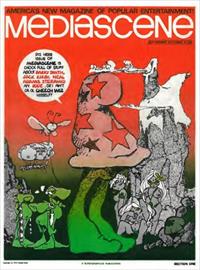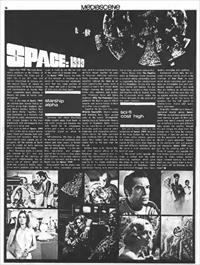Mediascene


"America's new magazine of popular entertainment", Mediascene was published by comic artist Jim Steranko. The bimonthly magazine began life as Comixscene in December 1972, the focus shifted to include film and TV and was renamed as Mediascene with issue 7, December 1973. There was still a strong focus on comics and art, and issue 15, dated September/October 1975 was a special comics issue. Among the non-comics articles were coverage of the new films Rollerball and Jaws, and, on page 16, Space: 1999. In 1980 the magazine was retitled again as Prevue, running until 1994.
September 1999. The most devastating explosion in the history of mankind blasts the moon out of orbit. On it are 311 men and women determined to survive, pitted against forces of nature so extraordinary, life forms so strange, and environments so hostile that their unexpected space odyssey is beyond the grasp of human comprehension.
This is the saga of Space: 1999, on exciting new science fiction adventure series from England, starring Martin Landau. Barbara Bain and Barry Morse. Together, they find themselves on a fantastic trek through the stars, encountering new and unusual dangers in the most expensively and extravagantly budgeted sci-fi series ever.
The premise behind Space: 1999 is that, in the not so distant future, space travel will become both commonplace and necessary. When extraterrestrial radio signals are intercepted, all the nations of Earth unite to create an early warning system, located on the moon.
Thus, Moonbase Alpha is created and manned by 311 men and women from all the countries of the world. Unfortunately, the excessive use of atomic power on earth has created a deadly radioactive waste problem, and the decision is made to use the far side of the moon as a storage area.
As Space: 1999 begins, the folly of this decision is revealed as a series of thermonuclear explosions occur that tear away portions of the moon and send it hurtling out of orbit and into deep space.
Somehow still intact, Moonbase Alpha careens away from Earth. It can never return, and becomes the only world for its inhabitants, whose goal is now to find a new, compatible planet on which to settle.
Self-sustaining, the base is able to maintain survival conditions with atomic and solar power; a fateful journey through the incredible vastness of space begins. It is the conflict, exploration and struggle against the life-forms in deep space that becomes the primary concern of the 311 survivors, and the spring board idea for Space; 1999.
Incorporated into the show's concept is every successful element ever used in a science-fiction series, skilfully drawn together to cater to American television audiences. Stars, directors and writers hove carefully tailored the show to attract sophisticated tastes, with a record six and a half million dollar budget insuring the quality with better sets, costumes and production, Producers Gerry and Sylvia Anderson (UFO, The Protectors) hove gathered the best in special effects experts and science-fiction authors to further insure credibility.
Together for the first time since Mission: Impossible, Martin Landau and Barbara Bain hove pivotal roles in the series' development. Landau stars as Commander Koenig, leader of Moonbase Alpha, chosen for his contribution of outstanding leadership qualities, superior space knowledge and unequalled administrative ability. He holds command over scientists from all nations because their leaders hove acknowledged him as the best man for the job.
Barbara Bain is Dr. Helena Russell, chief medical officer of the Moonbase. Her responsibilities include the maintenance of the psychological, emotional and physical stability of the Alpha inhabitants. Her sphere of influence extends to Commander Koenig, with whom she has a close, personal relationship.
Barry Morse, from The Fugitive, stars as Professor Victor Bergman, a scientist whose remarkable work is responsible for the establishment of the Moonbase. At one time Koenig's mentor and teacher, the professor has remained a close friend, and together with Dr. Russell, forms the triumvirate which makes the critical decisions for the survival of the space travellers.
Sets are a major aspect in the production of Space: 1999. Because of the large budget for the series 24 shows, entire planets, galaxies and elaborate cities hove been designed. In fact, every show features new and different locations, giving the series a truly expensive, epic
In the series' initial episode, the moon is rocked with the orbit-shattering explosion which gives the show its start, and the many personalities of Moonbase Alpha are delineated through their fears, doubts, strengths and conflicts.
Subsequent shows take the survivors to other worlds, much in the tradition of Star Trek, to meet weird aliens (including such guest stars as Christopher Lee) and mysterious galactic perils. One week they ore bottling on all-consuming "black sun" and the next they are up against war-like creatures from another age. In all, the series 24 episodes run the full gamut of science-fiction drama and space- opera adventure.
Originally intended as a network- sponsored weekly series. Space: 1999 has instead been picked-up by local stations as part of their pre-prime time family viewing, and will run at different times and different days across the country. Though this will remove the show from the ratings race that rules the network schedules, it does not entirely rule out the possibility of continuation should if prove successful. Thanks to its impressive cost and production standards, Space: 1999 could just be the sleeping giant of the 75-76 TV season, and possibly the first totally science-fiction oriented series to make money without major network booking. But then, what can you expect from a series that starts off by blowing up the moon?